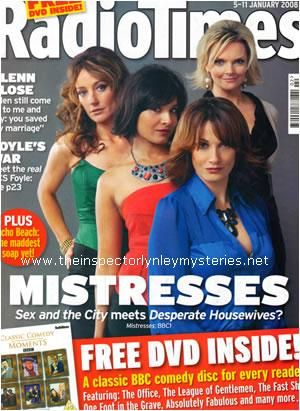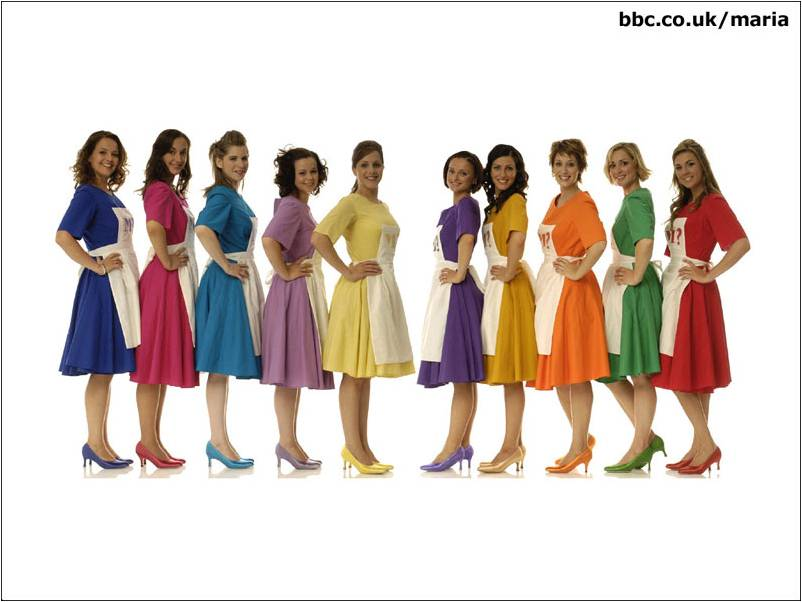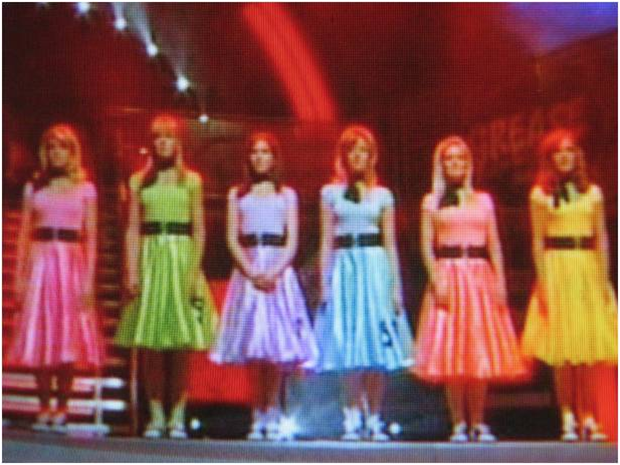Postfeminist Primary Colors: Coding Femininities in Media Culture
Hannah Hamad / Massey University

In a key moment in Frank Oz’s iconically postfeminist 2004 remake of The Stepford Wives, beleaguered husband Walter Kresby (Matthew Broderick), in an attempt to assert masculine authority, tells his wife Joanna Eberhart (Nicole Kidman), that from now on, he wants her to wear “no more black,” because “only high-powered, neurotic, castrating, Manhattan career bitches wear black.” He thus bluntly articulates the way in which the early part of the film has construed postfeminist femininity using a rhetoric of colour, and how it has been found wanting, as suggested by the monochromatic visual aesthetic embodied by Joanna and her look, and Walter’s damning characterization of what it signifies. Walter and Joanna have arrived at this face-off following their downshift to Stepford, heralded by Joanna’s work induced mental breakdown. Thereafter, Joanna resolves that as part of the renegotiation and reevaluation of her sense of self, specifically her femininity, that this has prompted, she will abandon black, and re-signify her feminine identity according to a different kind of postfeminist template, more in keeping with the hyper-domesticity she finds to be the dominant characteristic of the local women of Stepford. In subsequent scenes, her look instead conforms to the color coordinated aesthetic of pastels and/or primary colors that uniformly adorns the eponymous Stepford wives. In this way, the film overtly addresses the cultural tendency to signify particularities about some of the ways that femininities are conceptualized in postfeminism through color-coding.
There is a body of work in media studies addressing the meanings produced and communicated by the use of color in texts, and the potential for color to signify ideologically. For example, Judith Williamson highlighted its connotative potency in visual representational culture in her foundational work on ideology and advertisements. She argued that the “use of color is… a technique, used primarily in pictorial advertising to make correlations between a product and other things.”1 Kress and Van Leeuwen have theorized “colour [sic] as a semiotic mode,”2 noting that “differentiation” is one major signifying functionary of what they call the “grammar of colour [sic].”3 They further point to the potential for colors to do ideological work through their signification, as they can “be used and combined… to realize… different ideological positions,”4 and in this way they have suggested “it is possible to see colour [sic] as the sign of a complex of discourses around femininity.”5 Veronica Koller has discussed this as having the potential “to both reproduce and challenge gender ideology,” specifically in this instance in reference to the color pink as an over-determined, ironic or recuperated signifier of femininity in postfeminism.6 Thus Koller is one of several scholars who have latterly addressed the phenomenon of color-coding as a strategic visual mode in popular media with which to articulate particular meanings about feminine identities and subjectivities in postfeminism. This work has tended to focus on dichotomous black/white visual aesthetics,7 or in the reclamation of (the formerly disavowed) pink as a signifier of femininity, with particular and new connotations in the context of postfeminism.8 Here I propose the postfeminist significance of a visual rhetoric of primary colors, which effects controlled differentiation, and the ideologically loaded reduction of femininity to a selection of subject positions, which are limited to a handful of female archetypes.
Postfeminist media culture evinces a tendency towards representing groups of women, who are marked as subjects of postfeminism, as reductively individuated and glibly differentiated through visual coding across the spectrum of primary or otherwise bright colors, in line with the notion that Brenda Weber has elsewhere articulated in relation to the de-individuation of femininity in reality TV makeover shows, that femininity is operating culturally according to an “economy of sameness.”9 In No Logo, her iconic treatise on the post-industrial, globally corporate condition, Naomi Klein noted that “Within a context of manufactured sameness, image based difference had to be manufactured along with the product.”10 In a similar way, manufactured sameness and basic image based difference marks the mediation of femininities in postfeminism across a plethora of media forms, genres and contexts to a notable degree, and the frequently occurring highly visible instances of color-coded femininities are symptomatic of this.

Popular music acts like The Saturdays, serial television dramas like Mistresses (BBC, 2008-present), and reality T.V. shows like Real Housewives of Orange County (Bravo, 2006-present) and How Do You Solve a Problem Like Maria? (BBC, 2006), to name just some examples, have all articulated particularized formulations of postfeminist femininity via the representation of discrete groups of de-individuated women. Each group is depicted as homogenously embodying an over-determined trope of postfeminist femininity (e.g. housewife chic, nanny chic, empowered girlhood, liberated sexuality etc.), while individual personae are constrained in their ability to manifest themselves, aided in part by the disingenuous strategy of differentiation that individuates these women through color-coding them. A clear visual shorthand is thus provided for purposes of crude separation, while ensuring that individuality does not transcend the postfeminist archetype being articulated by the women’s group identity.
[youtube]http://www.youtube.com/watch?v=smHe6-6LdII[/youtube]
How Do You Solve a Problem Like Maria? was a British reality TV talent competition that saw a group of women competing for the chance to play the role of Maria in a West End musical theatre revival of The Sound of Music. With respect to some of the strategies of representational subjugation and identity management practiced by postfeminist culture, a rhetoric of color was in place throughout the show of bright, safe primary colors that reassuringly encoded the contestants as pleasingly and simplistically individualised but not worryingly diverse. Each contestant was assigned a colour, and was consistently dressed in costumes of this colour while performing on stage in the live segments of the show.
[youtube]http://www.youtube.com/watch?v=eZJkdRUd5JA[/youtube]
This would remain so throughout the rest of the series both while the contestants were dressed in the iconic aproned costumes, and in their different but still color-coded costumes for their individual performances, as this phase of the competition necessarily walked a line between the homogenisation and differentiation of the contestants. The color-coded costumes worn by “the Marias” were awash with significance in terms of the coding of their identities (‘Tomboy Maria’ was assigned a blue costume, ‘Irish Maria’ was assigned a green costume, ‘Sexy Maria’ a red costume etc.) Meanwhile the connotations of the apron adorned by the symmetrical multitude of beaming “Marias” semiotically facilitated a spectacle and enabled the enactment of a fantasy of female servility due to the strong implications of domesticity, childcare and the role of women attendant to it. These are all issues which are of course bound up with the character of Maria who becomes a governess to a stern and authoritarian widower. In this way the reductive manner in which femininities were individualised did not outshine their collective signification of Maria, and the mode of femininity she embodies.

Furthermore, in line with the gender specific nature of many of these strategies of identity management, this color-coding (and hence de-individuation) did not take place for the contestants of the later search in Any Dream Will Do (BBC, 2007) for a male lead to star in Joseph and the Amazing Technicolor Dreamcoat to nearly the same extent. This homogenisation and attendant pseudo-individuation of female competitors in reality TV has similarly taken place in comparable series Grease Is The Word (BBC, 2007), and its US counterpart Grease: You’re The One That I Want (NBC, 2007),11 and the BBC’s own follow up show I’d Do Anything (BBC, 2008), while the colour-coding of male competitors was likewise downplayed, understated or non-existent in each case. It remains to be seen if the current iteration of this cycle of reality TV shows, Over The Rainbow (BBC, 2010) will likewise adopt the visual strategy of coding its Dorothys by colour to articulate particular and reductive subject positions for its female contestants.

This phenomenon of colour-coding, as illustrated by the textual examples mentioned here, is just one example of the numerous discursive, rhetorical and representational strategies of de-individuation that postfeminist culture continues to enact upon mediated femininities.
Image Credits:
1. Color-coded postfeminist femininity in the BBC’s Mistresses
2. Individuation by colour in Real Housewives of Orange County
3. The final ten contestants perform the title song on How Do You Solve a Problem Like Maria?
4. Color-coded Sandys in Grease: You’re The One That I Want (Author screen grab)
- Judith Williamson, Decoding Advertisements: Ideology and Meaning in Advertising (London & New York: Marion Boyars, 1978), p. 24. [↩]
- Gunther Kress and Theo Van Leeuwen, ‘Colour as a Semiotic Mode: Notes for a Grammar of Colour’ Visual Communication, Vol. 1, No. 3 (2002), p 343. [↩]
- Ibid., p 343. [↩]
- Ibid., p 366. [↩]
- Ibid., p 363. [↩]
- Veronika Koller, ‘Not Just a Colour’: Pink as a Gender and Sexuality Marker in Visual Communication’ Visual Communication, Vol. 7, No. 4 (2008), p 418. [↩]
- See for example, James R. Knecht, ‘It Really Isn’t All Black and White: Colour Coding, Postfeminism and Charmed’ in Karin Beeler and Stan Beeler (eds) Investigating Charmed: The Magic Power of TV. (London and New York: IB Tauris, 2007), pp. 143-153. [↩]
- In addition to Koller, see also Michelle M. Lazar, ‘Entitled to Consume: Postfeminist Femininity and a Culture of Post-Critique’, Discourse and Communication, Vol. 3, No. 4 (2009), pp 371-400. [↩]
- Brenda R. Weber, ‘Beauty, Desire and Anxiety: The Economy of Sameness in ABC’s Extreme Makeover’ Genders, No. 41 (2005), http://www.genders.org/g41_weber.html. [↩]
- Naomi Klein, No Logo (London: Flamingo, 2000), p. 6. [↩]
- Thanks to Susan Pearlman for DVDs. [↩]
Great piece, Hannah. And as I wasn’t aware of any existent media scholarship on color, I now have some things to read.
Your piece also makes me think of Heathers in terms of how members of the clique were organized by color. While all of them adhered to a uniform look, the colors they were associated with indicated aspects of their personalities. Ringleader Heather Chandler was red, a color associated with power and dynamism. Second-in-command Heather Duke was green, which in addition to being red’s complement, is also a hue associated with sickness (i.e., bulimia) and envy. Notably, when Duke takes over the clique after Chandler’s death, the power grab is visually connoted through Duke wearing Chandler’s red scrunchie. Heather McNamara is yellow, a primary color that suggests cowardice and makes transparent McNamara’s ineffectual nature. Notably, she has no underling who wears purple.
Of course, Veronica is blue — a primary color associated with sadness. Veronica’s application is edged with a considerable amount of black, which differentiates her from the other girls and their use of color. And just as Chandler has a subordinate friend assigned a secondary color that complements its primary counterpart, Veronica was once friends with nerdy Betty Finn. Predictably, she wears orange.
I think these interactions speak to the power dynamics inherent in female friendships and is essential to reading this text.
This was a really great read and akin to many of the semiotic discourses I have been following in color-coding, especially in Japanese New Wave cinema. But I love how you have integrated Naomi Klien’s No Logo into the mix. The concept of postfeminism has such as tight relationship with capitalism, I would have loved to see you dig more into this connection. Especially, when looking at contemporary programming and marketing in television there are oodles of observations that can be made considering how color coding in marketing relates to the kind of color-coding of individualism and gender that you suggest here in this article. Especially looking at the picture of The Real Housewives of Orange County, these dress colors scream the kinds of values, personalities, and characters these people embody on the programming—even to a layman as myself.
But we need to be wary on how absolute these semiotic observations may be, especially as these programs take on a transnational context. This has sparked an interest in how varied and oppositional these kinds of representation are with a foreign audience. But you have a strong foundation in linking the commercialism of media marketing with the reductive imagery placed upon these women. As @Alyx Vesey suggests, looking into at the power-relations between these women on these programs is pretty imperative in seeing how there women are represented and clearly commodified to the audience. Awesome work, and I can’t wait to see where you go from here.
Although you did not address the Real Housewives tableau, I find the tension between individuality and group aesthetic intriguing here. You touch on the concept of constrained individuality, which is evident in this picture especially. The most valuable plot for that season seemed to be the growing drama between Gretchen (red) and Tamra (black), who are appropriately placed opposite each other and wearing the most dramatic colors, while the other housewives occupy a less contentious space in the center with innocuous color schemes. There may be something to consider just in the many iterations of the Real Housewives tableaux on bravotv.com.
Hi Hannah, Fascinating take on the construction of ‘safe’ femininities in post-feminist culture. The significance of (pseudo?) individualization is so central to the neo-liberal ideology which post-feminism operates in conjunction with and seems to really play off of Western discourses about the importance of the individual. So thanks for this fresh take on some of these ideas…
I couldn’t help but think of the Sex and the City movie where Samantha, Charlotte, and Miranda all wear solid primary color bridesmaid dresses for Carrie’s wedding as another example of this post-feminist color-coding…and yes, Samantha wore red!
Fascinating article, Hannah. As I read through your piece, I couldn’t help but laugh at the silly circumstances of my own childhood, growing up post-feminist in the face of a traditional Grandmother. The modeling classes I had begrudgingly taken to appease her. The cast of evangelical troglodytes shoving “Color Me Beautiful” down my throat, as if that would excise the cynical, tomboyish wunderkind I grew into. I’m still unclear of the season my femininity represents, though if personality should weigh in, I’d guess I’m a cold, dark, nasty winter.
For as long as I can recall, however, being a post-modern baby and all, color and femininity have always been linked. And this is, in part, due to the push to appeal to female consumers. As studies in motivational research blossomed in the 1960s, including color appeal, we saw a boom in the rainbow of colored appliances. “Make life brighter,” a New York telephone company exec said of a boom in multicolored telephones. And lest we not forget the need to match your avocado kitchen aid to your avocado fridge and avocado cooking set. So it was only natural, with the woman stepping outside this private realm in the 1970s and forward, that she brings the Cainian mark of consumer branding with her into the world.
Now a color like pink, which had forever been the modicum of princessial femininity in consumer culture is more akin to an incurable disease—cancer—than anything we’d want to buy as a way of distinguishing our females selves. When it comes to the post-feminine female the only color that truly matters…is green.
I’m constantly fascinated by postfeminism’s attempt to package and sell individuality, while keeping its consumers safely homogeneous. Women are encouraged to define themselves by minute differences that they purchase rather than non consumerist means. I was always struck by the sameness of the woman of Sex and the City, rather than by their supposed differences. Charlotte the chaste one seemed to go through just as many men as Samantha the sexy one, but Charlotte wore pink and Samantha wore red so it must be true. Then I think of the number of marketing campaigns and magazines spreads that asked which Sex and the City girl are you? All you have to do is buy the accoutrement of one of these characters and you too can be sassy sexy Samantha and define yourself as unique and special.
I see this a lot in Glee. In this context all of the characters are supposedly on a team and thus should match, but they always put their own individual spin on it. Quinn’s clothes are altered to hide the baby bump and Mercedes shows less skin, while Rachel is always adding preppy touches. The differences are so minute, but so important in distinguishing them from the automaton’s of their competition, Vocal Adrenaline. Once again it encourages this consumerist self-identification and the idea that you must wear your individuality, while allowing for very little actual variation.
Great article. BBC carrying on the colour coding theme in Dorothy
This instantly made me think of bridesmaids’ dresses. Traditionally, bridesmaids wear matching dresses in the same color (often pink), but some “modern” brides have begun put each bridesmaid in a different primary color. We see this in the Sex and the City movie (as @Jessalynn points out), and the trend has caught on for real weddings. The idea, I assume, is to allow each bridesmaid to express her individuality. Or, at the very least, to choose a color that is flattering. But rarely are two women are permitted to wear the same color.
After reading this article and gazing at the accompanying photos, I can’t help wondering if assigning individual colors to the bridesmaids gives them less autonomy instead of more.
This was an excellent article… although the phenomenon is obviously right in front of us on television, it had completely escaped my conscious attention. It was particularly distressing to think of Sharon Small and her wonderfully individualised characterisation of D.S. Havers – complete with an endless array of completely unflattering poofy jackets and layers of sweaters – in the “Inspector Lynley” mysteries, being reduced to a black dress.
When contextualized as you’ve done here, I can extrapolate what are probably the leading characteristics of her character in “Mistresses”: a career woman, fairly conservative, probably either interested in having kids but torn up because she doesn’t have the time, or put forward as even more of a hard-charger who doesn’t want them at all. If it’s the former, she probably has a little pink on her pj’s.
It’s depressing to think that this kind of schematization of stereotypical characteristics could be thought of, beyond the artificiality of ‘reality television,’ as an end point for character development, rather than a quick though obvious visual shorthand when *establishing* characters. I think it does point out the series of emblematized ‘problems’ or ‘issues’ that women are said to be facing in a post-feminist construction of women’s lives and which therefore stand in for all the messy contradictions that define real people versus the sketches of bad writers. The fact that audiences would still be willing to accept such laziness in an age of ambitious storytelling in much of TV Land (with concomitantly higher expectations for male characters!) makes feminism seem not quite so ready for that post-feminist tombstone.
Pingback: Casalinghe disperate: da Stepford a Wisteria Lane |